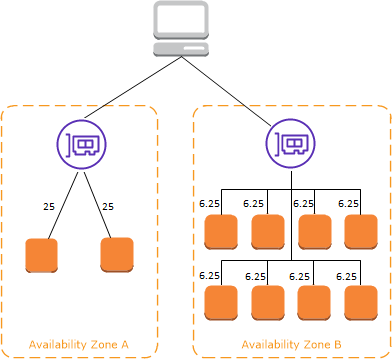A load balancer accepts incoming traffic from clients and routes requests to its registered targets (such as EC2 instances) in one or more Availability Zones. The load balancer also monitors the health of its registered targets and ensures that it routes traffic only to healthy targets. When the load balancer detects an unhealthy target, it stops routing traffic to that target. It then resumes routing traffic to that target when it detects that the target is healthy again.
You configure your load balancer to accept incoming traffic by specifying one or more listeners. A listener is a process that checks for connection requests. It is configured with a protocol and port number for connections from clients to the load balancer. Likewise, it is configured with a protocol and port number for connections from the load balancer to the targets.
Elastic Load Balancing supports the following types of load balancers:
- Application Load Balancers
- Network Load Balancers
- Gateway Load Balancers
- Classic Load Balancers
There is a key difference in how the load balancer types are configured. With Application Load Balancers, Network Load Balancers, and Gateway Load Balancers, you register targets in target groups, and route traffic to the target groups. With Classic Load Balancers, you register instances with the load balancer.
Availability Zones and load balancer nodes
When you enable an Availability Zone for your load balancer, Elastic Load Balancing creates a load balancer node in the Availability Zone. If you register targets in an Availability Zone but do not enable the Availability Zone, these registered targets do not receive traffic. Your load balancer is most effective when you ensure that each enabled Availability Zone has at least one registered target.
We recommend enabling multiple Availability Zones for all load balancers. With an Application Load Balancer however, it is a requirement that you enable at least two or more Availability Zones. This configuration helps ensure that the load balancer can continue to route traffic. If one Availability Zone becomes unavailable or has no healthy targets, the load balancer can route traffic to the healthy targets in another Availability Zone.
After you disable an Availability Zone, the targets in that Availability Zone remain registered with the load balancer. However, even though they remain registered, the load balancer does not route traffic to them.
Cross Zone Load Balancing
The nodes for your load balancer distribute requests from clients to registered targets. When cross-zone load balancing is enabled, each load balancer node distributes traffic across the registered targets in all enabled Availability Zones. When cross-zone load balancing is disabled, each load balancer node distributes traffic only across the registered targets in its Availability Zone.
The following diagrams demonstrate the effect of cross-zone load balancing with round robin as the default routing algorithm. There are two enabled Availability Zones, with two targets in Availability Zone A and eight targets in Availability Zone B. Clients send requests, and Amazon Route 53 responds to each request with the IP address of one of the load balancer nodes. Based on the round robin routing algorithm, traffic is distributed such that each load balancer node receives 50% of the traffic from the clients. Each load balancer node distributes its share of the traffic across the registered targets in its scope.

In above diagram Cross Zone Load Balancing is Enabled and each of 10 targets receive 10% of the traffic as each Load Balancer node can route 50% of client traffic to all 10 targets.
If cross-zone load balancing is disabled:
- Each of the two targets in Availability Zone A receives 25% of the traffic.
- Each of the eight targets in Availability Zone B receives 6.25% of the traffic.
This is because each load balancer node can route its 50% of the client traffic only to targets in its Availability Zone.

With Application Load Balancers, cross-zone load balancing is always enabled at the load balancer level.
With Network Load Balancers and Gateway Load Balancers, cross-zone load balancing is disabled by default.After you create the load balancer, you can enable or disable cross-zone load balancing at any time.
With Classic Load Balancer the option to enable cross-zone load balancing is selected by default. After you create a Classic Load Balancer, you can enable or disable cross-zone load balancing at any time.